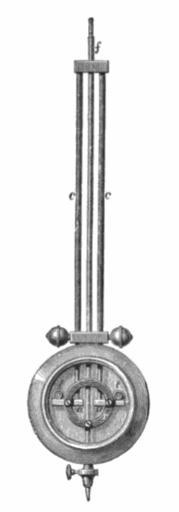MAKE A MEME
View Large Image

| View Original: | Ellicott_pendulum.png (276x791) | |||
| Download: | Original | Medium | Small | Thumb |
| Courtesy of: | commons.wikimedia.org | More Like This | ||
| Keywords: Ellicott pendulum.png John Ellicott in 1752 used in some small French mantel clocks in the 1800s from a French physics book from 1878 Around a foot long The central rod f is made of iron while the two peripheral rods c are made of brass which has a higher thermal expansion With a rise in temperature the central rod expands and gets longer but the two brass rods expand more and press down on the levers a which press up on the pins t attached to the bob raising the bob This compensates for the lengthening of the central rod keeping the bob at the same distance from the pendulum pivot Therefore the pendulum's length to its center of mass and its period of swing stays constant with changes in temperature Because of the more complicated mechanism its temperature compensation was probably inferior to the more widely used gridiron pendulum and the Ellicott pendulum was not used in many clocks <br /><br /> Alterations to image Removed caption rotated to compensate for scanning error converted from JPG to PNG Downloaded 2008-12-28 from http //books google com/books id 1m4PAAAAYAAJ pg PA272 Augustin Privat Deschanel Joseph David Everett 1878 Elementary Treatise on Natural Philosophy D Appleton Co New York p 272 fig 207 translated from Privat Deschanel's Traité Élémentaire de Physique by Joseph David Everett on Google Books Augustin-Privat Deschanel 1878 Public Domain - Deschanel died in 1881 Everett in 1904 PD-old John Ellicott Pendulums Gridiron pendulums | ||||